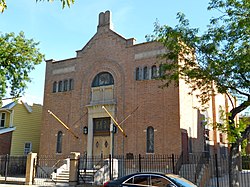History
Between the 1870s and the 1930s, thousands of Syrians immigrated to New York City. They immigrated from the region of Ottoman Greater Syria, now known as the Levant. Greater Syria includes what is now Syria, Lebanon, Israel, and Palestine. Immigrants from Ottoman Syria were known as "Syrians", although after the independence of Lebanon in the 1920s, some of the Syrians began to identify as Lebanese. While Syrians/Syro-Lebanese immigrants settled across the United States, New York City became the central hub of the Syrian diaspora in America. The heart of New York City's "Syrian Colony" was Little Syria in downtown Manhattan. By the early 1900s, Syrians from Little Syria began to settle in Brooklyn. [2] Syrian Christians belonged to multiple denominations, including the Maronite Church, the Greek Orthodox Church of Antioch, and the Melkite Greek Catholic Church. Prior to the 1960s, Syrian Muslims were a small and largely invisible population compared to the Arab Christian population. Many of the Syrian Muslims emigrated from the region of Palestine. [3] There are educational and economic divides among the Syrian population, with Syrian Christians and Syrian Jews having higher levels of educational and economic achievement compared to the Syrian Muslim community, which is more likely to experience poverty and educational barriers. [4]
When Syrian Jews first began to arrive in New York City during the late 1800s and early 1900s, Eastern European Ashkenazi Jews on the Lower East Side sometimes disdained their Syrian co-coreligionists as Arabische Yidden, Arab Jews. Some Ashkenazim doubted whether Sephardi/Mizrahi Jews from the Middle East were Jewish at all. In response, some Syrian Jews who were deeply proud of their ancient Jewish heritage, derogatorily dubbed Ashkenazi Jews as "J-Dubs", a reference to the first and third letters of the English word "Jew". [5]
This page is based on this
Wikipedia article Text is available under the
CC BY-SA 4.0 license; additional terms may apply.
Images, videos and audio are available under their respective licenses.





